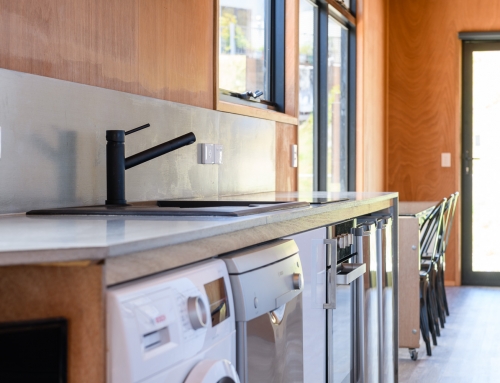Why Shipping Containers
Many Australians face similar issues in relation to their living arrangements, and two of the biggest ones are finding affordable places to live and making the effort to take care of the environment. Container homes embrace modular living in a way that addresses both affordability and the opportunity for sustainable living. Knowing the pros and cons of container houses in Australia will help you decide if this type of home is a viable option for you.
What Are Shipping Container Homes?
Shipping container homes offer affordable, customisable alternatives to conventional home construction. Like the name suggests, they’re made using steel shipping containers – the kind you often see stacked on cargo vessels moving goods around the world.
Most shipping containers fall into two size categories:
- 20 feet x 8 feet (6.1 metres x 2.4 metres): 160 square feet or roughly 14.6 square metres of space
- 40 feet x 8 feet (12.2 metres x 2.4 metres): 320 square feet or roughly 29.3 square metres of space
Either container size would be feasible as a tiny home on its own or a business office in a bigger build. The great thing about container homes is that there are many different ways that you can put them together, so you can use a combination of two or more containers for a larger or even multi level residence.
What Are the Potential Benefits and Drawbacks?
Creating a shipping container home in Australia can mean enjoying a durable, affordable, and customisable residence. However, customisation is sometimes difficult, and eco-friendliness isn’t a given.
Possible Advantages
There are many benefits when considering a container home, including:
- Mobility: Many shipping container homes are self-enclosed, so a transport service can actually pick up your home and move it anywhere you want in the whole world.
- Durability: Many shipping containers are made using corten steel because it is self-healing and protects ocean cargo. Weathering steel helps your container home withstand the elements.
- Modular Living: Easy modifications let you mix and match containers to design your own home layout with specific spaces and rooms.
- Fast Construction: Prefabricated container homes can show up move-in ready. If you use contractors, many of them can construct your shipping container home in just a few weeks.
- Affordability: The amount of labor and building materials involved are a fraction of building a conventional home. That means the price of a shipping container home is also just a fraction of what a normal house costs.
Possible Disadvantages
Shipping container houses in Australia obviously have many potential advantages to them, but they’re not perfect. Be mindful of some possible pitfalls with them, too:
- Reinforcements Necessary: Cutting holes for windows and doors can compromise their structural integrity so you may have to put in additional reinforcements.
- Flat Roofing: The roofs aren’t sloped to handle draining precipitation and therefore installing roof drainage is highly important.
- Difficulties with Modern Appliances: Unless you are considering living off the grid, wiring a home like this to the grid can be a challenge unless you find a licensed electrician with experience in container architecture. The same goes for plumbing.
- Building Permits: Forward-thinking governments are open to ideas that alleviate the housing crisis in Australia, but actually getting permission is different in every jurisdiction.
- Not Always Eco-Friendly: Repurposing a used shipping container can be a good environmental move, but it might have also been used to move hazardous chemicals, in which case it would not be an ideal home. Buying a new shipping container for your home, on the other hand, is certainly not recycling and is therefore much less eco-friendly.
Preparation is Key
If you decide that you are going to build a container home, there are ways in which you can prepare to ensure your build goes smoothly and that any potential problems are dealt with or even solved before they can occur. We have put together a list of how you can prepare for building your new home.
- Understand the costs: Making a budget and keeping it in mind when building your home will help keep surprise costs to a minimum.
- Building Permits: Every council will have different permits, and having the correct ones is imperative to getting your container home built quickly. Make sure you contact your local council to understand what permits you are required to obtain before you start building.
- Natural light: Considering containers are made out of steel to transport goods long distances, the availability of natural light is limited. Consider adding skylights, glass doors, and windows to your design to make the space brighter and look more open. High-cube containers are available if you are looking for higher ceilings.
- Inspect your new home: Inspecting your container before you purchase it ensures that you are not going to get any surprises when it arrives. Look for dents, holes, or rusting as these can be expensive to fix up later.
- Understand where the limitations lie: When determining whether a container home is right for you, do your research, and find out the environmental and climate constraints that exist around your potential plot of land.
Container homes are an affordable alternative to conventional homes that are more environmentally friendly (if you are using a recycled one) and can be made completely self-sufficient. At Containered, we endeavour to bring your dream home to life. We will work with you to determine what you need in terms of permits, design, and fittings. For more information, contact us today at info@containered.com.au.







